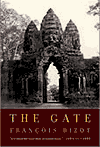|
|
| |
BOOK
REVIEW
Exposition
of revolutionary terror
The Gate, by Francois Bizot
Reviewed by Sreeram Chaulia
For a long time during the Cold War, Cambodia
remained in the shadow of Vietnam. To the
outside world it was a "sideshow"
(journalist William Shawcross). Yet the
monumental devastation and human loss that
ideological hatred foisted on the home of the
Khmers in the 1970s was unparalleled in all of
Asia. Francois Bizot, a French historian of
Buddhism, was the only Westerner to live
through the time of Cambodia's obscurity by
surviving and escaping a Khmer Rouge prison
camp. From such a rare species comes a rare
testimony of the proverbial lull before the
storm, the prelude to genocide and the
spine-chilling "killing fields". Spy
novelist John le Carre, who fictionalized
Bizot's experiences in The Secret Pilgrim,
writes in the foreword: "He is the
authentic version of what the rest of us can
only imagine."
Bizot's earliest memories of mid-'60s Cambodia
are rose-tinted. "The land was rich and
beautiful, enameled with paddy fields, dotted
with temples. This was a country of peace and
simplicity." (p 3) Compared with the
later wave of terror and irreparable damage,
the pristine image sits uncomfortably in
Bizot's mind. "This constant split vision
pulled me apart like some schizophrenic
illness." (p 6) From the painful side of
the vision, Bizot sees the gate of the French
Embassy in Phnom Penh, a piece of fragile mesh
that resisted so many strong hopes and opened
itself to so many heavy wrongs in 1975. The
harrowing consciousness of this gate forms the
theme of the book.
In 1970, Bizot was in Angkor doing field
research on local Buddhist traditions when the
US-backed military dictatorship of Lon Nol was
installed in Cambodia. Resistance, aided by
the North Vietnamese, was engaging the pro-US
government in bloody guerrilla warfare. To
rural Cambodians, "this war was totally
foreign" (p 15). Villagers who wished
only to preserve their centuries-old Buddhist
ways of life did not know what to think of the
communists or of the government, both of whom
were harassing them endlessly for conscripts
and grain. Stuck in stereotypes of Vietnam,
European intelligentsia took commando raids on
the government army to be a spontaneous and
independent popular rebellion. The truth, as
Bizot witnessed it, was that ordinary Khmers
feared the Vietnamese invaders as much as Lon
Nol.
Around 1971, Bizot detected a new "hidden
organization" that was making life hell
for peasants - the Khmer Rouge. "In
contrast to the North Vietnamese, whose
mission was to fight the republican army,
their role was to sow terror, under the cover
of the forests." (p 26) On a trip to a
monastery in Oudong, Bizot and his
co-researchers were ambushed by a Khmer Rouge
convoy and dragged on foot to an unknown
destination. Charged with ideological fervor,
his interrogators took him to be an American
spy spreading "imperialism". Bizot
heard his captors discuss a solution to this
French-Khmer-speaking Central Intelligence
Agency (CIA) agent. "Undress him and
shoot him! What are you waiting for
comrades?" (p 37) The Khmer Rouge's
trademark style was to strip victims before
shooting them so that the garments could be
reused.
Miraculously spared through the intervention
of higher-ups, Bizot was chained under a
chhlik tree in a forest glade camp and barely
kept alive. "The first few days last a
lifetime ... the voice of revolt, little by
little, dies away." (p 43) Since there
was no spare container for Bizot, he was
denied the morning meal. The miserly rice
morsel of the evening was all Bizot's camp
commander Ta Douch allowed.
Gradually, Bizot developed a strange
attachment and respect for Douch despite the
fact that he was his tormentor (a la the
"Stockholm Syndrome", where the
kidnapped undergo affection for their
captors). In conversations with Douch to prove
his innocence, Bizot gleaned a touch of
brutality and cold robotic terror that was to
become the hallmark of the man who would go on
to supervise the Tuol Sleng torture prison in
Phnom Penh. References to "cleansing the
sins", "ridding our country of
vermin", driving sense into those
"benumbed by Buddhism", and the
total disdain with which Douch and his
subordinates treated crops, gardens, trees,
pathways and other sacred symbols were signs
of the apocalypse to come. Douch's superiors
included the who's who of Khmer Rouge butchers
- Ta Mok, Von Veth, Saloth Sar (aka Pol Pot).
In the tradition of the leaders, Douch
proclaimed, "the only way is to terrorize
enemies, isolate them and starve them ... it's
better to have a sparsely populated Cambodia
than a country full of incompetents". (p
116)
Oddly, the same automaton who carried out
beatings and shootings remorselessly, Douch,
was somewhat sympathetic to Bizot and started
believing in his blamelessness. "This
terrible man was not duplicitous: all he had
were principles and convictions." (p 77)
He yearned to project a pure, upright image of
the Khmer Rouge and was known to punish
indiscipline, theft or other crimes among his
subalterns. So taken was Bizot by the romantic
image of the upright revolutionary that he
played mind games putting himself in Douch's
shoes: "It occurred to me that in his
place, I, too, would have had what it takes to
be a good torturer." (p 98) Douch
petitioned his bosses and overcame obstinate
refusals finally to secure Bizot's release
months after his incarceration. "My
freedom had become a sort of personal success
for him." (p 127)
In 1975, when the Khmer Rouge rode
triumphantly into Phnom Penh, Bizot was in the
capital and noticed the same naivete clouded
by Vietnam among French diplomats. They still
believed the Khmer Rouge to be a popular
uprising against US intervention in Cambodia.
They would be eating their words in days.
Spreading deliberate lies that "American
bombardments" would start, Khmer Rouge
ordered the evacuation of Phnom Penh at
gunpoint. Displaced persons were allowed no
more than one piece of luggage and herded into
long queues for slave labor in foreordained
collective farms and factories.
Bizot's linguistic abilities and the crowding
of the French Embassy with stranded foreigners
and fleeing Khmers suddenly turned him into
the official interpreter in an extended drama
of negotiations between international citizens
and Khmer Rouge soldiers. Virtually under
house arrest, thousands of trapped inmates
used Bizot to express their fears, views and
requests to the new authorities. High figures
of the Lon Nol regime such as Sirik Matak and
other counter-revolutionaries took shelter
inside the embassy, inviting repeated armed
raids by Khmer Rouge into the compound.
Beyond the embassy gate, Bizot observed
"a violence so terrible and so explosive
that I felt totally disheartened". Khmer
Rouge forces were indulging in a spree of
looting and mass murder unknown to Cambodian
history. Petrified civilians ran pell-mell to
protect themselves from bullets and
commandeering troops. "They sank the hole
of their black pupils into our eyes,
bequeathing us a fragment of their fear."
(p 174) Caught in a surreal tragedy of epic
proportions, Bizot found the fragile balance
of his sanity often tipping. In disturbing
trances, he would see mangled bodies of his
Khmer colleagues imprisoned by Douch sticking
out of a mass grave. As the embassy compound
wilted from dwindling supplies, space and
indefinite confinement, well-behaved human
beings unexpectedly forked out baser instincts
- theft, jealousy, selfishness and aggression.
The most shocking aspect of the reign of
terror was that there were Parisian
intellectuals who approved of everything that
was occurring. Fraternizing genocidaires as
"liberators" was a most repulsive
business that encouraged Pol Pot's sadistic
blueprint for extermination. The Khmer Rouge
grew concerned that news of the death squads
was leaking out through radio broadcasts from
the French Embassy and demanded immediate
closure of all telecommunications, an order
Bizot reluctantly conveyed to the journalists
and embassy staff who were relaying
commentaries on the situation in Phnom Penh.
Witness accounts of the atrocities were
filtering through, a loophole that had to be
instantly plugged by sealing Cambodia.
At the end of May 1975, the Khmer Rouge
decided to organize a repatriation of all
marooned foreign nationals to Thailand while
"internal stability" was restored in
Cambodia. On the troublesome truck journey out
of the country, Bizot passed through areas of
"liberated" territory that seemed to
have grown poorer and more exhausted since the
"people's revolution". Fields were
hoed, villages razed, skulls smashed, pagodas
burned and bridges blown up. Bizot realized
then that in the storm he was leaving behind,
dark powers would crush under their feet
"in blood-drenched soil, victim upon
victim ... the dangers of war were slight in
comparison to the dangers of revolution".
(p 260)
The Gate suffers from incongruously
verbose passages describing landscapes,
animals and characters in the manner of a
literary novel. But as a blow-by-blow
narrative of Cambodia's descent into chaos, it
is a valuable primary source for Cold War
history. Years after George Orwell exposed the
dark underbelly of Stalinist totalitarianism,
Bizot has given us another bare-knuckles
exposition of revolutionary terror.
The Gate, by Francois Bizot, Alfred A
Knopf Publishers, New York, 2003. ISBN:
0-375-41293-X. Price: US$24. 276 pages.
(Copyright 2003 Asia Times Online Co, Ltd. All
rights reserved. Please contact [email protected]
for information on our sales and syndication
policies.) |
| |
|
|
 |
|
| |
|
|
|
| |
|
|
|
|
|













